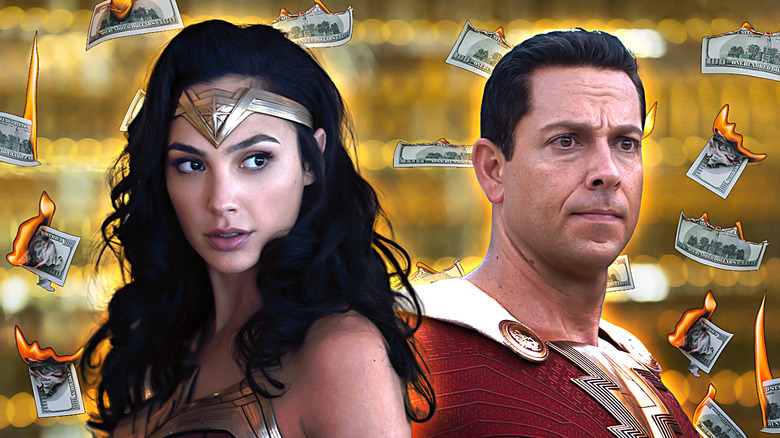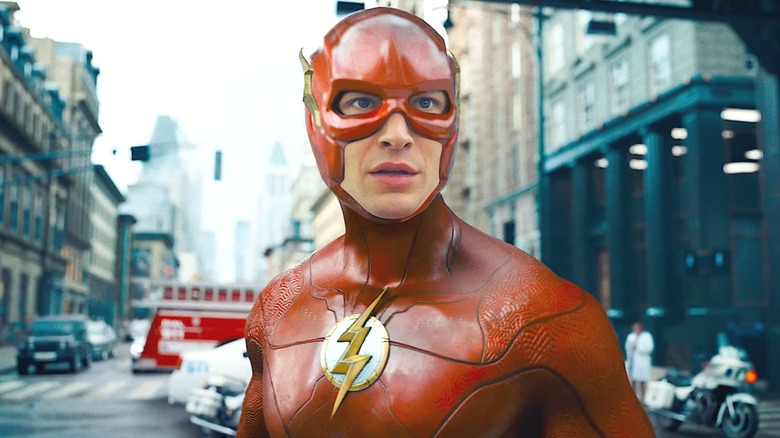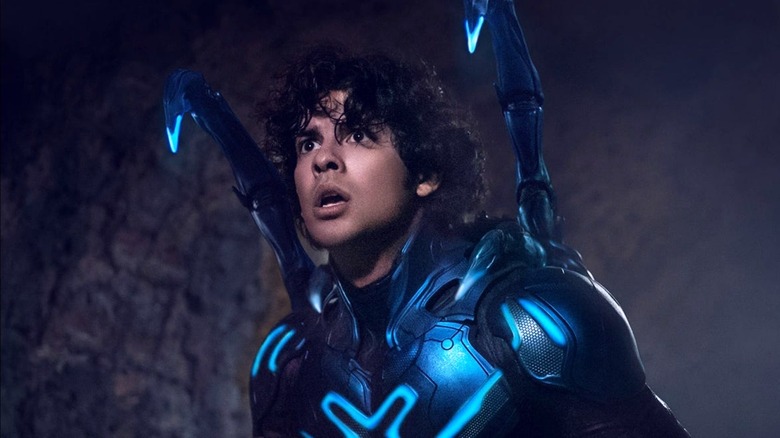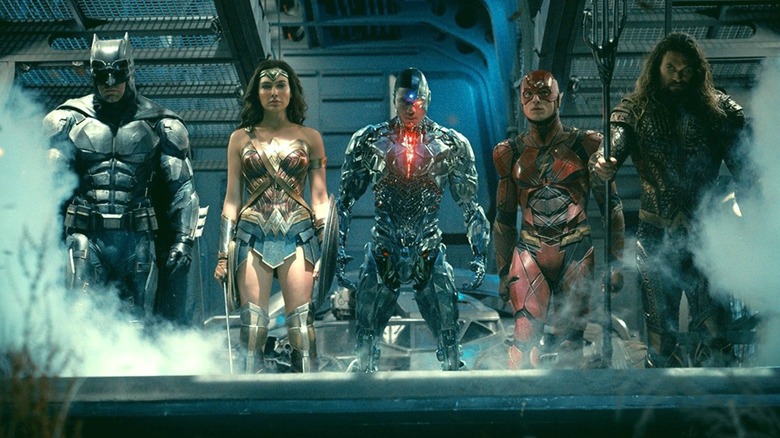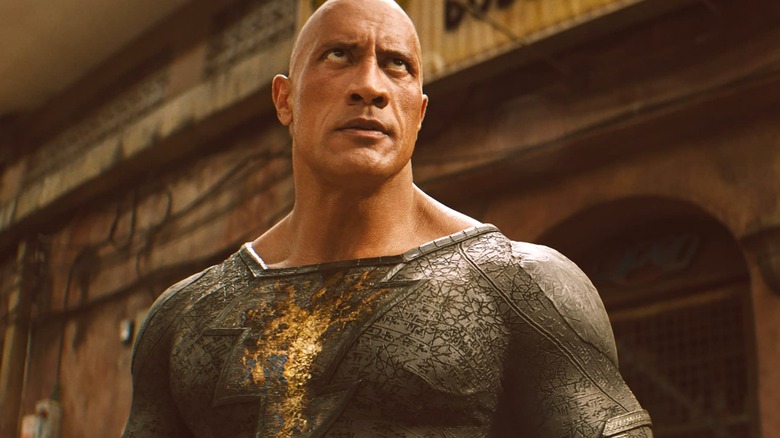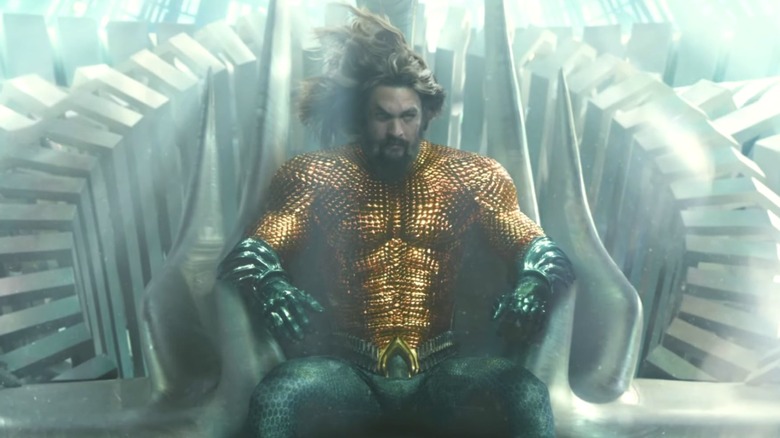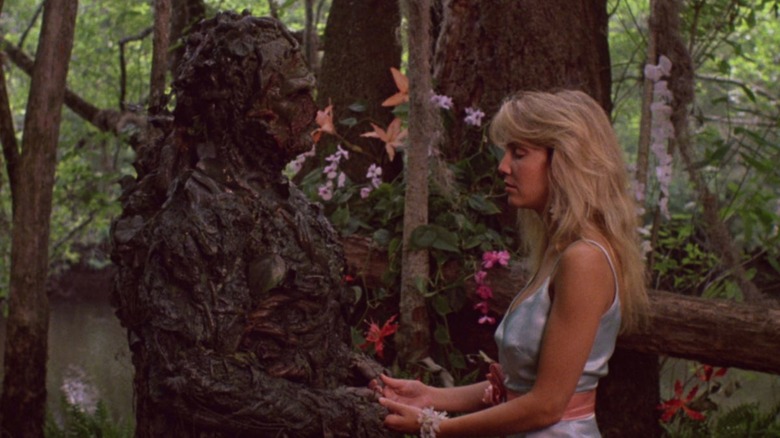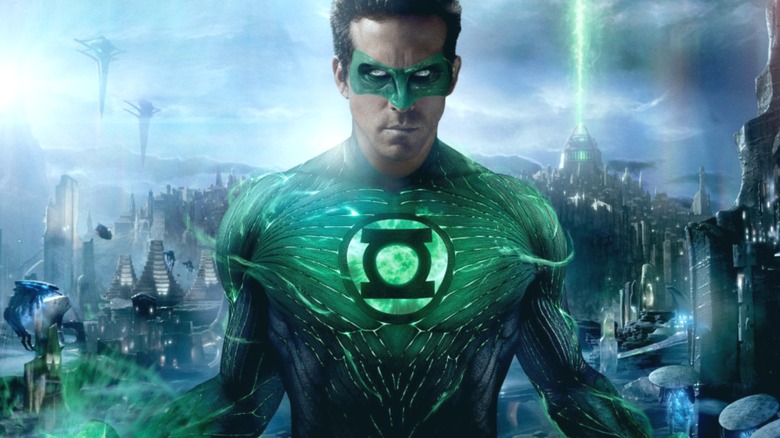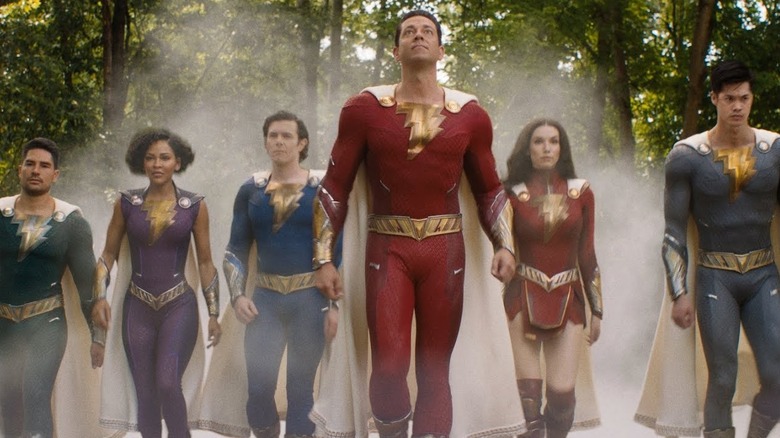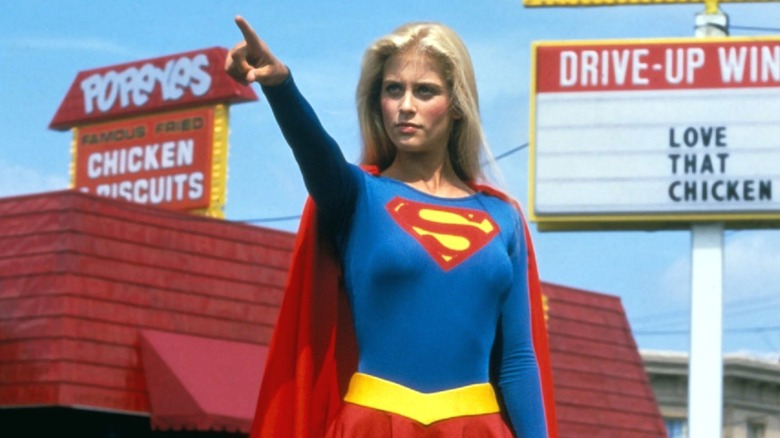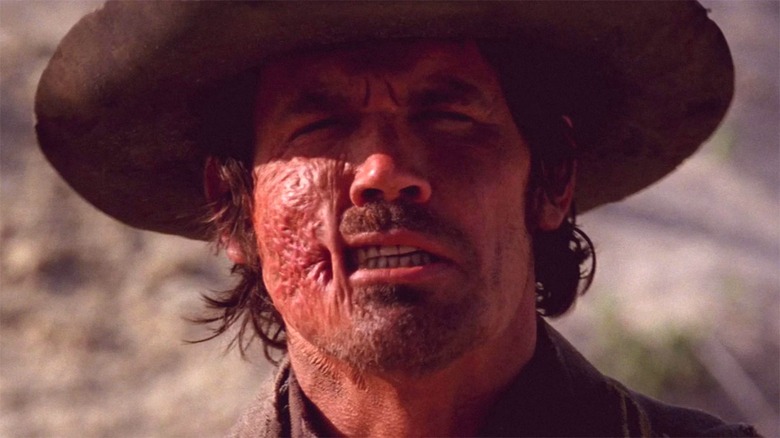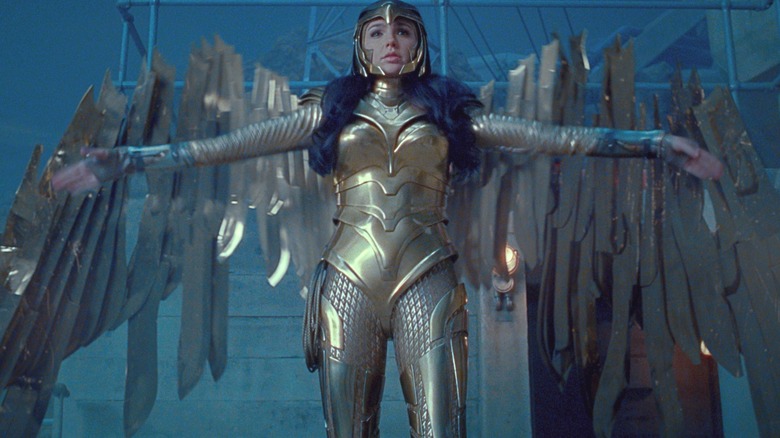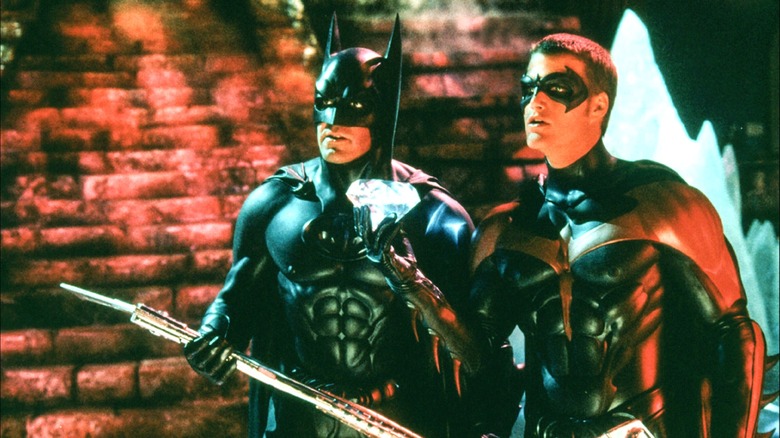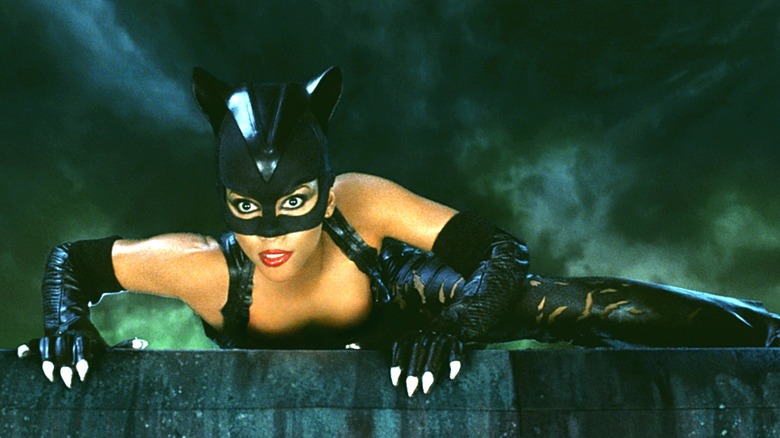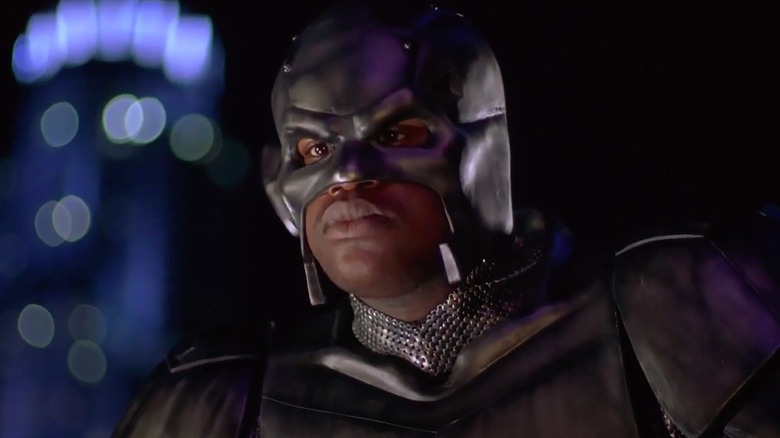Why These DC Movies Bombed At The Box Office
DC Comics adaptations once dominated the superhero movie world. The first Christopher Reeve-led "Superman" film was huge in 1978, and Tim Burton's first "Batman" flick also made a splash when it landed just over a decade later. 1989's "Batman" changed superhero movies forever, and Christopher Nolan carried on the evolution of Batman — and DC movies in general — when he made his Dark Knight trilogy across the 2000s and 2010s.
Of course, even back then, there were some DC flops. For every hit there have been several failures, and in recent years, DC Comics adaptations have bombed at an alarming rate. Seven films in the DC Extended Universe bombed in a row, leading to a reboot set to launch in 2025 via James Gunn and Peter Safran. While that may turn things around for Warner Bros., there are still many DC failures in the studio's past.
If a film doesn't make around 200% of its production budget, it's considered a financial failure. That's because studios often spend the same amount as they do on production on things like distribution, theater shares, and marketing, meaning this amount is usually needed just to break even. The following DC movies tried to emulate the success of their predecessors, but they all bombed at the box office.
The Flash couldn't overcome bad CGI and a problematic lead
By the time the DC Extended Universe got around to giving the Scarlet Speedster his own movie, the ship had already sailed. 2023's "The Flash" was one of the last movies in the faltering franchise, and its star didn't do the movie any favors. Allegations of misconduct against Ezra Miller brought a lot of negative attention to the picture, and it was, unsurprisingly, a box office disaster.
The film cost anywhere between $200 million and $220 million to make, with estimates indicating that it needed to pull in around $400 million to break even. It didn't come close to that, earning only $271 million at the global box office. While Miller's actions off-camera were a problem, the film itself garnered numerous complaints: For one, the cartoonish CGI in "The Flash" bordered on embarrassing.
Several scenes (including the CGI babies seen at the beginning of the movie) are jarringly bad, and the film suffered for it. In an age where photorealistic CGI is becoming the norm, "The Flash" looked amateurish. When word got out that the effects in the film were poor, it was the nail in its box office coffin.
Blue Beetle is a charming but forgettable film
Blue Beetle is a popular DC Comics character who's been around since 1939. Still, despite his long history, he hasn't had much representation outside of comics, cartoons, and minor TV appearances. As such, Blue Beetle's fanbase is on the smaller side, so there wasn't a huge crowd of people waiting for his movie. Casting Xolo Maridueña of "Cobra Kai" fame in the title role was a smart move by Warner Bros., but even his charisma couldn't save this film from financial failure.
It's estimated that 2023's "Blue Beetle" cost $120 million to produce, but it only made around $130 million at the global box office. Part of the reason this happened was a poorly structured marketing campaign, which didn't bring many folks unfamiliar with the character to theaters. "Blue Beetle" was also the penultimate film in the DCEU, and people were already looking forward to the reboot at this point. This further limited the reach of the movie, which came and went with little fanfare. There are numerous reasons why "Blue Beetle" bombed at the box office, but to summarize, average moviegoers simply weren't interested in seeing it.
Justice League made tons of cash and still bombed
2017's "Justice League" was supposed to be Warner Bros. and DC's answer to "The Avengers," but, even though it made a decent chunk of change, it was still a financial flop. Production was problematic due to director Zack Snyder having to leave before completing the film due to personal reasons. Joss Whedon was brought aboard, with execs hoping that he would sprinkle some of that Marvel magic on the project, though his vastly different approach just made things worse.
Warner Bros. pumped an estimated $300 million into the production. Spending so much meant that the break-even point was around $750 million, which was a high bar to reach. In the end, the film earned $661 million worldwide, costing the studio nearly $100 million in losses. Everything went wrong for "Justice League" at the box office. Whedon's lighter take was jarring next to the work done by Snyder, and the script was also an issue. The story was generic and relied too heavily on a villain, Steppenwolf, who wasn't rendered well in CGI and was largely forgettable.
Dwayne Johnson got too involved in Black Adam
Black Adam is another DC character who was largely unknown by those unfamiliar with the comics. That's not always a problem, as Marvel Studios proved with "Guardians of the Galaxy." 2022's "Black Adam" also had a huge star in the lead role in Dwayne Johnson, who promoted the movie extensively. He also reportedly exerted a lot of creative control, which ultimately didn't help. "Dwayne tries to sell himself as bigger than the movie," one exec told TheWrap anonymously. "Instead of making a movie, he wants to extend his brand and make a brand centered on himself."
What's more, "Black Adam" jammed in a number of previously unseen characters. This was a risky move when superhero film fans expect connective tissue and cameos (Johnson reportedly nixed the idea of Zachary Levi's Shazam appearing in a post-credits scene). Of course, Johnson pressuring the studio to get his own way is not the only reason why "Black Adam" bombed at the box office – the DCEU was already in its death throes at this stage, and the film also had some stiff competition, with Marvel's "Black Panther: Wakanda Forever" coming out soon after.
"Black Adam" cost around $200 million, so its box office take of around $393 million wasn't anywhere near enough to justify the expense. When all was said and done, Warner Bros. lost as much as $100 million on the film.
Aquaman and the Lost Kingdom should have been released a lot sooner
The first "Aquaman" film was a rare success for the DCEU, so a sequel was inevitable. Unfortunately, Warner Bros. waited too long: Five years had passed by the time "Aquaman and the Lost Kingdom" hit theaters in 2023. When it did, the DCEU was already dead. Surprisingly, "Aquaman and the Lost Kingdom" did rather well at the box office, pulling in over $434 million. Unfortunately, while that more than covered the film's $205 million production budget, the film still failed to make a profit.
"Aquaman and the Lost Kingdom" reportedly needed to make somewhere between $510 million to $555 million just to break even, which was always going to be a big ask. As such, the second "Aquaman" film bombed at the box office, largely due to superhero fatigue. The market is oversaturated these days, turning people away. That, on top of some poor critical reactions, meant the film was destined to sink.
The Return of Swamp Thing dropped the horror
Long before the DCEU, DC released a variety of movies that weren't in an interconnected universe. One such movie, 1982's "Swamp Thing" (which was directed by horror legend Wes Craven) received mixed to positive reviews, with veteran film critic Roger Ebert giving it three out of four stars. It didn't do huge business at the box office, but home video sales were encouraging, so a sequel was greenlit. "The Return of Swamp Thing," which was helmed by prolific B-movie director Jim Wynorski, hit theaters in 1989.
"The Return of Swamp Thing" had a lot going for it, with Heather Locklear of "Dynasty" and "T.J. Hooker" fame taking on the role of Abby Arcane. Unfortunately, the follow-up dumped many of the horror elements from the first movie and embraced a more cheesy, unrealistic depiction of the classic DC character, which is the main reason it flopped. Execs probably saw this as a low-risk venture, since it only cost around $4 million to produce. However, it made just $274,928 at the box office, making it a box office bomb. Its performance wasn't helped by the fact that it screened in only 123 theaters and ran for just one week in each on average.
Green Lantern's overreliance on CGI turned many away
Green Lantern has been a fan-favorite DC character for decades, but it took a long time before he arrived on the silver screen. In 2011, Ryan Reynolds took the reins as Hal Jordan and brought the character to life. Unfortunately, his highly anticipated outing was a massive flop: The film cost $200 million to produce and only made $237 million at the box office. "Green Lantern" was meant to launch a new film universe, but it bombed so hard that DC scrapped those plans.
There are several reasons why "Green Lantern" bombed at the box office, but first and foremost was its overreliance on visual effects. The decision to make the main character's costume with CGI was a misguided one. It appears more cartoonish than anything, and its goofy appearance in trailers apparently put people off. Reynolds even joked about this in "Deadpool" and its sequel, demanding that his "super suit" not be green or animated. In "Deadpool 2," Deadpool travels back in time and kills Reynolds before he can accept the role, so at least the film's star has a good sense of humor about this massive failure.
Shazam! Fury of the Gods failed to recapture the magic of the original film
The first "Shazam!" film did very well at the box office, but the buzz had died off by the time follow-up "Shazam! Fury of the Gods" hit cineplexes in 2023. Leading man Zachary Levi gave it his all in the sequel, but there were several factors that made "Shazam! Fury of the Gods" a box office bomb, from Levi's controversial comments about COVID-19 vaccinations to the movie landing right as superhero fatigue was kicking in.
One thing it had going for it was a sensible budget: The film wasn't prohibitively expensive, costing Warner Bros. $125 million to produce. While that's no small sum, it's less than what the studio has spent on other DC tentpoles. Unfortunately, even though it didn't need to make as much as other DC films in order to break even, "Shazam! Fury of the Gods" only pulled in $134 million at the box office, once more costing Warner Bros. a ton of cash.
Supergirl needed a Christopher Reeve cameo
Released in 1984, the first live-action "Supergirl" movie (a spin-off from Christopher Reeve's "Superman" film franchise) was a massive misfire. The filmmakers made the mistake of significantly altering the established lore of the character (played here by Helen Slater), which didn't sit well with fans. DC lovers might have been able to get on board with some of the changes had the script been decent, but the story told was nonsensical and negative word of mouth did damage to the flick's earning potential.
"Supergirl" dropped to almost universal disappointment, and not even the work of legendary actors Peter O'Toole, Faye Dunaway, or Mia Farrow could save this train wreck. The film was expensive for the time, costing an estimated $35 million to produce, and it quickly became a box office bomb with only $14 million in worldwide ticket sales. Ultimately, the film was doomed by a bad story, terrible acting choices, and a lack of involvement by Christopher Reeve, who (quite understandably) refused to make a cameo appearance.
Jonah Hex just wasn't well-known enough
Josh Brolin is known for playing Thanos in the Marvel Cinematic Universe, but long before he played the Mad Titan, he took on the titular role in DC's "Jonah Hex." The trouble was, unless you were a fan of the comics, you probably hadn't heard of the character, and this was one of the main reasons the film failed at the box office when it dropped in 2010.
"Jonah Hex" features an all-star cast, including Brolin, John Malkovich, Megan Fox, Michael Fassbender, Will Arnett, and Michael Shannon, who went on to play Zod in "Man of Steel." Unfortunately, all of that talent couldn't save this film, which somehow dragged and was too short at the same time, running for just 81 minutes. That's especially short when introducing a new character to audiences.
"Jonah Hex" was inexpensive for a superhero film, costing $47 million to produce, but its box office take was far below that number at $10.9 million. Oddly enough, the movie started out strong, but quickly fell apart. The story crumbles as things progress, which critics were quick to pick up on. When word got out that this Western action flick wasn't worth your time, the box office receipts suffered.
Wonder Woman 1984 was hit hard by the COVID-19 pandemic
2017's "Wonder Woman" is an excellent film that introduced the character to a whole new generation of fans. It performed very well, so Warner Bros. was bound to prioritize a follow-up — or so everyone thought. It took three years for "Wonder Woman 1984" to materialize, and when it did, it was hampered significantly by the COVID-19 pandemic. The sequel was delayed six times before it was released in December 2020, at the height of the pandemic. Warner Bros. made the controversial decision to release it simultaneously to theaters and via HBO Max.
Bringing the movie to streaming obviously had a big impact on the box office haul: The $200 million production only made $169.6 million at the box office. While COVID is largely to blame for the film's rocky release, and it certainly diminished its earning potential (analysts say the sequel lost $100 million at the box office), it's not the only reason the movie failed. Critics derided the film's ridiculous plot, wooden villain, and the nature of Wonder Woman's relationship with a kind-of reincarnated Steve Trevor. Pandemic or not, "Wonder Woman 1984" wouldn't have stood up to the original.
Batman & Robin lacked everything that made Tim Burton's movies so great
Director Tim Burton surprised the world with the highly successful "Batman" in 1989. However, after turning in a solid sequel (1992's "Batman Returns"), Burton left the franchise. The third film (1995's "Batman Forever") was directed by Joel Schumacher. It wasn't objectively awful, but Schumacher's follow-up, 1997's "Batman & Robin," is a cautionary tale of how not to make a superhero movie. The film was so bad it killed the "Batman" film franchise for the best part of a decade.
Burton's films are dark and brooding while still having some campy elements. "Batman & Robin" has none of the former and overloads on the latter. Forgetting the so-called Bat-Nipples and other ridiculous additions to the costume, the film is bright and colorful and filled with so many nauseating one-liners that it's hard to take seriously. Schumacher apparently envisioned his live-action movie as if it was a cartoon, and it didn't work.
"Batman & Robin" cost the studio $125 million to produce, which was a lot in 1997. Ticket sales weren't too bad all things considered, with the film bringing in $238 million at the box office, but it failed to break even and is considered to be one of the worst superhero movies ever made. Years later, George Clooney apologized for the film, though he reprised the role as a joke at the end of "The Flash."
Catwoman strayed too far from the comics
One of the worst things filmmakers can do when making a superhero movie is to completely disregard the comics. This is what happened with Halle Berry's "Catwoman" (2004), which bears no resemblance to the comics outside of the film's title. Instead of Selina Kyle, Catwoman is Patience Phillips, and she has no connection to Batman or her comic book counterpart.
While some may be able to overlook that, comic book fans didn't, and, more than that, it's just a bad movie on every level. The script is terrible, the CGI is dreadful, and the costume Berry wears as Catwoman doesn't make any sense. "Catwoman" cost $100 million to produce and only made $82 million at the box office.
The project being stuck in development hell for a long time didn't help matters, costing the film any continuity with the established "Batman" films. The movie was so bad that it won four Razzies, including one for Berry, who accepted the "award" in person while holding her best actress Academy Award. Like Ryan Reynolds with "Green Lantern," at least she had a sense of humor about her DC bomb.
Steel needed a big-name star
When DC killed Superman in the '90s, the publisher introduced four potential replacements. One was a former weapons designer named John Henry Irons. He's similar to Marvel's Iron Man in that he's behind the creation of weapons and he built a suit of armor to fight injustice in the world. Steel was popular enough for a film to get the greenlight, with none other than basketball star Shaquille O'Neal in the title role. The movie was not given a sizable budget, and it shows in Steel's terrible costume: Think Iron Man if you ordered him from Wish.
Despite costing just $16 million to make, 1997's "Steel" only managed to pull in around $1.8 million at the box office, making it a huge box office bomb and one of the worst superhero movies ever made. According to the director, it bombed so hard because O'Neal didn't have the star power needed for a superhero vehicle. "I said, 'Guys, if you're gonna put Shaq in the lead, then you've got to at least have a major movie star next to them. Or at the very least, a few in some supporting roles so that the picture can open well,'" Kenneth Johnson told Vice.
